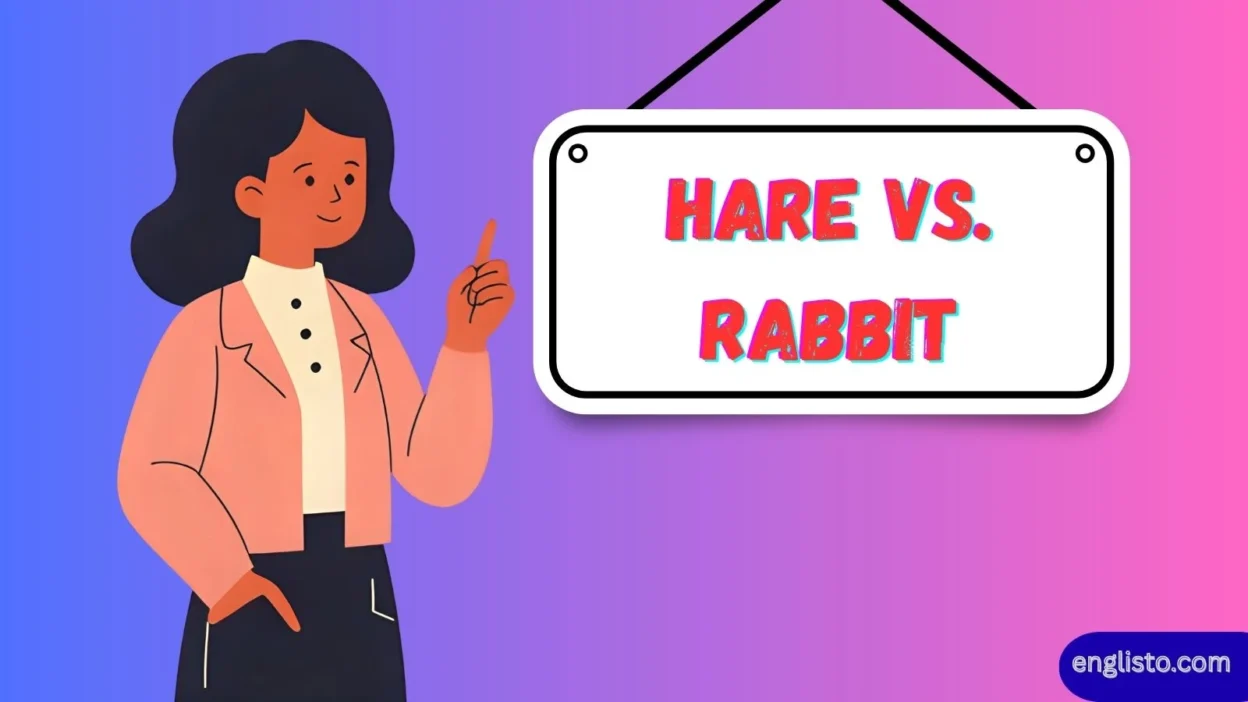If you’ve ever stood still in a countryside field or even glanced into a suburban garden at dusk, you’ve probably spotted a small, furry mammal darting into the grass. But was it a rabbit or a hare? Many people use these words interchangeably—sometimes even calling both “bunnies.” Yet, while they belong to the same biological family (Leporidae), hares and rabbits are different animals with distinct features, behaviours, and fascinating histories. Hare vs. Rabbit.
This guide dives deep into the hare vs. rabbit debate, covering their anatomy, lifestyle, behavior, symbolism, and role in ecosystems. You’ll find tables, real-life examples, cultural references, and biological facts to clear the confusion once and for all.
Origins of the Words “Hare” and “Rabbit”
Language gives us clues about how long these animals have fascinated humans.
- The word hare comes from the Old English hara, related to German Hase and Dutch haas. It’s among the oldest animal names in English, dating back before the 12th century.
- The word rabbit entered English much later, in the 14th century, borrowed from Old French rabotte.
- Interestingly, before “rabbit” became standard, coney (from Latin cuniculus) was commonly used. You’ll still see echoes of this in place names like Coney Island in New York.
“Hare” has always referred to wild, swift, solitary creatures. “Rabbit,” however, gradually became associated with burrow-dwelling, sociable, and sometimes domesticated animals.
Physical Differences Between Hares and Rabbits
At first glance, they look similar: long ears, twitching noses, and powerful hind legs. But when you look closely, hares are built for speed and survival, while rabbits are designed for hiding and living in groups.
| Feature | Hare | Rabbit |
| Size | Larger, up to 4–5 kg | Smaller, usually 1–2.5 kg |
| Body Build | Slender, muscular | Compact, rounder |
| Ears | Longer, with black tips | Shorter, without black tips |
| Legs | Long, powerful hind legs | Shorter, adapted for quick sprints |
| Coat | Seasonal color changes (brown → white in snowshoe hares) | More consistent coat colors |
| Vision & Alertness | Wide field of vision, stay in open areas | Rely on cover and burrows for safety |
| Speed | Up to 70 km/h (45 mph) | Up to 56 km/h (35 mph) |
A hare racing across a meadow often looks like a blur of brown or grey, while a rabbit will zigzag short distances to reach its underground burrow.
Birth and Early Development
The biggest difference lies in how their babies enter the world.
- Rabbits give birth to kits that are:
- Blind
- Hairless (furless)
- Helpless (altricial)
- Born underground in burrows or warrens
- Dependent on their mother for several weeks
- Blind
- Hares give birth to leverets that are:
- Fully furred
- Eyes open
- Able to run within hours (precocial)
- Born above ground in shallow depressions called nests or “forms”
- More independent from the start
- Fully furred
| Aspect | Rabbits (Kits) | Hares (Leverets) |
| Birthplace | Underground burrows | Surface nests |
| Appearance at Birth | Blind, naked | Furred, eyes open |
| Mobility | Immobile, helpless | Can run shortly after birth |
| Survival Strategy | Hiding underground | Camouflage and speed |
Nature designed these differences as survival strategies: rabbits survive by hiding, hares by outrunning predators.
Social Structures and Lifestyle
Rabbits are highly social animals. They:
- Live in large groups called colonies
- Build extensive tunnels and warrens with multiple entrances
- Communicate through thumps, scent marking, and body language
- Show strong hierarchy and territorial behavior
Hares, in contrast, are solitary runners. They:
- Live alone or in loose pairs
- Do not build burrows—just nests in grass or fields
- Meet mainly for mating season, famously engaging in “boxing” when females fend off males in spring
Diet and Feeding Habits
Both hares and rabbits are herbivores (lagomorphs, not rodents), but they graze differently.
- Rabbits:
- Prefer grasses, hay, leafy greens, weeds, and vegetables
- Known for selective grazing, eating the most nutritious parts first
- Re-ingest their soft feces (cecotropes) to absorb extra nutrients
- Prefer grasses, hay, leafy greens, weeds, and vegetables
- Hares:
- Eat grasses, herbs, twigs, bark, buds, and crops depending on the season
- Adapt better to scarce winter food
- Snowshoe hares change diet as their coat shifts from brown to white with snow
- Eat grasses, herbs, twigs, bark, buds, and crops depending on the season
Behavior and Adaptations
- Speed and Escape:
Hares reach 70 km/h, zigzagging to confuse predators. Rabbits run shorter distances, around 56 km/h, quickly diving underground. - Camouflage and Coat Changes:
Hares often shift coat color with the seasons (brown in summer, white in snowy winters). Rabbits maintain more stable tones. - Predator Strategies:
- Rabbits: Hide, burrow, freeze in place
- Hares: Sprint, leap, and rely on early detection
- Rabbits: Hide, burrow, freeze in place
Cultural and Historical Significance
Hares and rabbits aren’t just biological creatures—they’re woven into folklore, religion, and popular culture.
- Hares in Folklore:
- Ancient symbols of fertility and springtime
- Associated with the moon in Greek, Chinese, and Celtic traditions
- Featured in the phrase “mad as a March hare” (from their energetic mating season)
- Ancient symbols of fertility and springtime
- Rabbits in Culture:
- Linked to Easter eggs and fertility rituals in Christianity
- “Bunny” became a term of endearment in English since the 1500s
- Made iconic in pop culture by Bugs Bunny (“What’s up, Doc?”)
- Linked to Easter eggs and fertility rituals in Christianity
Species Examples
| Common Name | Scientific Name | Type | Region |
| European Rabbit | Oryctolagus cuniculus | Rabbit | Europe, worldwide (domesticated) |
| Eastern Cottontail | Sylvilagus floridanus | Rabbit | North America |
| European Hare | Lepus europaeus | Hare | Europe, Asia |
| Snowshoe Hare | Lepus americanus | Hare | North America |
| Arctic Hare | Lepus arcticus | Hare | Polar regions |
Conservation Status
- Many rabbit and hare species are Least Concern on the IUCN Red List.
- Others, like the hispid hare (Caprolagus hispidus) and some rare rabbit species, are Near Threatened or declining due to habitat loss, disease, and hunting.
- In the UK, rabbits are considered common, while hares face local population declines.
Everyday Language: Why the Confusion Persists
People often call young rabbits “bunnies,” though technically they’re kits. Hares don’t have the same cuddly branding. Because of this:
- Rabbits became the stars of petting zoos and homes.
- Hares remained wild, aloof, and symbolic of mystery.
The confusion comes down to appearance, cultural use, and the fact that in casual speech, “rabbit” is friendlier, while “hare” feels old-fashioned.
FAQs
Are hares and rabbits the same species?
No. Both belong to the Leporidae family, but rabbits are mainly Oryctolagus and Sylvilagus, while hares are Lepus.
Which is faster, a hare or a rabbit?
Hares are faster, reaching up to 70 km/h, while rabbits average around 56 km/h.
Do hares burrow like rabbits?
No. Hares don’t dig burrows; they live in surface nests. Rabbits dig elaborate underground warrens.
Which one makes a better pet?
Rabbits are domesticated and make common pets. Hares are wild animals and not suited for domestication.
Why do hares change color in winter?
Some species, like snowshoe hares, molt seasonally to camouflage with snow and avoid predators.
Conclusion
While they share a family tree, hares and rabbits are different animals with unique adaptations. Rabbits are smaller, social burrowers with helpless young, while hares are larger, solitary sprinters with independent offspring. Both, however, play crucial roles in ecosystems and in human culture—whether as prey animals, cultural icons, or beloved companions.
Next time you see a furry blur in the fields, look closer: is it a swift, long-eared hare bounding across the meadow, or a rabbit darting for cover into a burrow?



